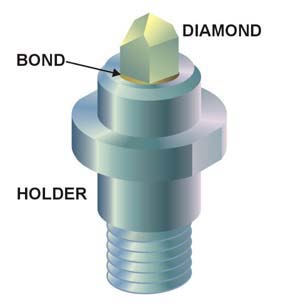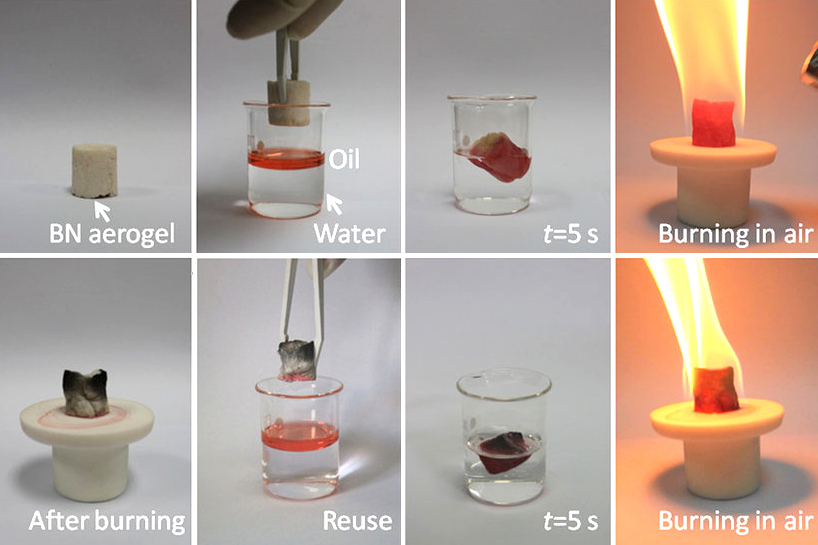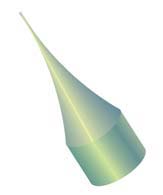|
Superhard Materials
A superhard material is a material with a hardness value exceeding 40 gigapascals ( GPa) when measured by the Vickers hardness test. They are virtually incompressible solids with high electron density and high bond covalency. As a result of their unique properties, these materials are of great interest in many industrial areas including, but not limited to, abrasives, polishing and cutting tools, disc brakes, and wear-resistant and protective coatings. Diamond is the hardest known material to date, with a Vickers hardness in the range of 70–150 GPa. Diamond demonstrates both high thermal conductivity and electrically insulating properties, and much attention has been put into finding practical applications of this material. However, diamond has several limitations for mass industrial application, including its high cost and oxidation at temperatures above 800 °C. In addition, diamond dissolves in iron and forms iron carbides at high temperatures and therefore is ineffic ... [...More Info...] [...Related Items...] OR: [Wikipedia] [Google] [Baidu] |
Vickers Hardness Test
The Vickers hardness test was developed in 1921 by Robert L. Smith and George E. Sandland at Vickers Ltd as an alternative to the Brinell scale, Brinell method to measure the hardness of materials. The Vickers test is often easier to use than other hardness tests since the required calculations are independent of the size of the indenter, and the indenter can be used for all materials irrespective of hardness. The basic principle, as with all common measures of hardness, is to observe a material's ability to resist plastic deformation from a standard source. The Vickers test can be used for all metals and has one of the widest scales among hardness tests. The unit of hardness given by the test is known as the Vickers Pyramid Number (HV) or Diamond Pyramid Hardness (DPH). The hardness number can be converted into units of pascal (unit), pascals, but should not be confused with pressure, which uses the same units. The hardness number is determined by the load over the surface area ... [...More Info...] [...Related Items...] OR: [Wikipedia] [Google] [Baidu] |
Cubic Boron Nitride
Boron nitride is a thermally and chemically resistant refractory compound of boron and nitrogen with the chemical formula B N. It exists in various crystalline forms that are isoelectronic to a similarly structured carbon lattice. The hexagonal form corresponding to graphite is the most stable and soft among BN polymorphs, and is therefore used as a lubricant and an additive to cosmetic products. The cubic ( zincblende aka sphalerite structure) variety analogous to diamond is called c-BN; it is softer than diamond, but its thermal and chemical stability is superior. The rare wurtzite BN modification is similar to lonsdaleite but slightly softer than the cubic form. Because of excellent thermal and chemical stability, boron nitride ceramics are used in high-temperature equipment and metal casting. Boron nitride has potential use in nanotechnology. History Boron nitride was discovered by chemistry teacher of the Liverpool Institute in 1842 via reduction of boric acid with ... [...More Info...] [...Related Items...] OR: [Wikipedia] [Google] [Baidu] |
Brinell Scale
The Brinell hardness test (pronounced /brəˈnɛl/) measures the indentation hardness of materials. It determines hardness through the scale of penetration of an indenter, loaded on a material test-piece. It is one of several definitions of hardness in materials science. The hardness scale is expressed in terms of a Brinell hardness value, sometimes referred to as the Brinell hardness number but formally expressed as HBW (Hardness Brinell Wolfram – Wolfram being an alternative name for the tungsten carbide ball indenter used during the test). The test was named after Johan August Brinell (1849-1925) who developed the method at the end of the 19th century. History Premiered by Swedish engineer Johan August Brinell at the 1900 Paris Exposition, it was the first widely used and standardised hardness test in engineering and metallurgy. The large size of indentation and thus possible damage to test-pieces limits its usefulness. However, it also had the useful feature that the h ... [...More Info...] [...Related Items...] OR: [Wikipedia] [Google] [Baidu] |
Nanoindenter
A nanoindenter is the main component for indentation hardness tests used in nanoindentation. Since the mid-1970s nanoindentation has become the primary method for measuring and testing very small volumes of mechanical properties. Nanoindentation, also called ''depth sensing indentation'' or ''instrumented indentation'', gained popularity with the development of machines that could record small load and displacement with high accuracy and precision. The load displacement data can be used to determine modulus of elasticity, hardness, yield strength, fracture toughness, scratch hardness and wear resistance, wear properties. Types There are many types of nanoindenters in current use differing mainly on their tip geometry. Among the numerous available geometries are three and four sided Pyramid (geometry), pyramids, Wedge (geometry), wedges, Cone (geometry), cones, Cylinder (geometry), cylinders, filaments, and spheres. Several geometries have become a well established common stan ... [...More Info...] [...Related Items...] OR: [Wikipedia] [Google] [Baidu] |
Mohs Scale Of Mineral Hardness
The Mohs scale ( ) of mineral hardness is a qualitative ordinal scale, from 1 to 10, characterizing scratch resistance of minerals through the ability of harder material to scratch softer material. The scale was introduced in 1812 by the German geologist and mineralogist Friedrich Mohs, in his book (English: Attempt at an elementary method for the natural-historical determination and recognition of fossils); it is one of several definitions of hardness in materials science, some of which are more quantitative. The method of comparing hardness by observing which minerals can scratch others is of great antiquity, having been mentioned by Theophrastus in his treatise ''On Stones'', , followed by Pliny the Elder in his ''Naturalis Historia'', . The Mohs scale is useful for identification of minerals in the field, but is not an accurate predictor of how well materials endure in an industrial setting. Reference minerals The Mohs scale of mineral hardness is based on the ability ... [...More Info...] [...Related Items...] OR: [Wikipedia] [Google] [Baidu] |
HPHT
A synthetic diamond or laboratory-grown diamond (LGD), also called a lab-grown, laboratory-created, man-made, artisan-created, artificial, or cultured diamond, is a diamond that is produced in a controlled technological process, in contrast to a naturally-formed diamond, which is created through Diamond#Geology, geological processes and Diamond#Mining, obtained by mining. Unlike diamond simulants (imitations of diamond made of superficially similar non-diamond materials), synthetic diamonds are composed of the same material as naturally formed diamonds—pure carbon crystallized in an isotropic 3D form—and have identical Material properties of diamond, chemical and physical properties. The maximal size of synthetic diamonds has increased dramatically in the 21st century. Before 2010, most synthetic diamonds were smaller than half a Carat (mass), carat. Improvements in technology, plus the availability of larger diamond substrates, have led to synthetic diamonds up to 125 car ... [...More Info...] [...Related Items...] OR: [Wikipedia] [Google] [Baidu] |
Plasticity (physics)
In physics and materials science, plasticity (also known as plastic deformation) is the ability of a solid material to undergo permanent Deformation (engineering), deformation, a non-reversible change of shape in response to applied forces. For example, a solid piece of metal being bent or pounded into a new shape displays plasticity as permanent changes occur within the material itself. In engineering, the transition from Elasticity (physics), elastic behavior to plastic behavior is known as Yield (engineering), yielding. Plastic deformation is observed in most materials, particularly metals, soils, Rock (geology), rocks, concrete, and foams. However, the physical mechanisms that cause plastic deformation can vary widely. At a crystalline scale, plasticity in metals is usually a consequence of dislocations. Such defects are relatively rare in most crystalline materials, but are numerous in some and part of their crystal structure; in such cases, plastic crystallinity can resul ... [...More Info...] [...Related Items...] OR: [Wikipedia] [Google] [Baidu] |
Shear Modulus
In materials science, shear modulus or modulus of rigidity, denoted by ''G'', or sometimes ''S'' or ''μ'', is a measure of the Elasticity (physics), elastic shear stiffness of a material and is defined as the ratio of shear stress to the shear strain: :G \ \stackrel\ \frac = \frac = \frac where :\tau_ = F/A \, = shear stress :F is the force which acts :A is the area on which the force acts :\gamma_ = shear strain. In engineering :=\Delta x/l = \tan \theta , elsewhere := \theta :\Delta x is the transverse displacement :l is the initial length of the area. The derived SI unit of shear modulus is the Pascal (unit), pascal (Pa), although it is usually expressed in Pascal (unit), gigapascals (GPa) or in thousand pounds per square inch (ksi). Its dimensional analysis, dimensional form is M1L−1T−2, replacing ''force'' by ''mass'' times ''acceleration''. Explanation The shear modulus is one of several quantities for measuring the stiffness of materials. All of them arise in ... [...More Info...] [...Related Items...] OR: [Wikipedia] [Google] [Baidu] |
Case Hardened Steel-vickers Hardness Test
Case or CASE may refer to: Instances * Instantiation (other), a realization of a concept, theme, or design * Special case, an instance that differs in a certain way from others of the type Containers * Case (goods), a package of related merchandise * Cartridge case or casing, a firearm cartridge component * Bookcase, a piece of furniture used to store books * Briefcase or attaché case, a narrow box to carry paperwork * Computer case, the enclosure for a PC's main components * Keep case, DVD or CD packaging * Pencil case * Phone case, protective or vanity accessory for mobile phones ** Battery case * Road case or flight case, for fragile equipment in transit * Shipping container or packing case * Suitcase, a large luggage box * Type case, a compartmentalized wooden box for letterpress typesetting Places * Case, Laclede County, Missouri * Case, Warren County, Missouri * Case River, a Kabika tributary in Ontario, Canada * Case Township, Michigan * Case del ... [...More Info...] [...Related Items...] OR: [Wikipedia] [Google] [Baidu] |
Nanoindenter Holder
A nanoindenter is the main component for indentation hardness tests used in nanoindentation. Since the mid-1970s nanoindentation has become the primary method for measuring and testing very small volumes of mechanical properties. Nanoindentation, also called ''depth sensing indentation'' or ''instrumented indentation'', gained popularity with the development of machines that could record small load and displacement with high accuracy and precision. The load displacement data can be used to determine modulus of elasticity, hardness, yield strength, fracture toughness, scratch hardness and wear properties. Types There are many types of nanoindenters in current use differing mainly on their tip geometry. Among the numerous available geometries are three and four sided pyramids, wedges, cones, cylinders, filaments, and spheres. Several geometries have become a well established common standard due to their extended use and well known properties; such as Berkovich, cube corner, ... [...More Info...] [...Related Items...] OR: [Wikipedia] [Google] [Baidu] |
Aggregated Diamond Nanorod
Aggregated diamond nanorods, or ADNRs, are a nanocrystalline form of diamond, also known as nanodiamond or hyperdiamond. Discovery Nanodiamond or hyperdiamond was produced by compression of graphite in 2003 by a group of researchers in Japan and in the same work, published in ''Nature'', it was shown to be much harder than bulk diamond. Later, it was also produced by compression of fullerene and confirmed to be the hardest and least compressible known material, with an isothermal bulk modulus of 491 gigapascals (GPa), while a conventional diamond has a modulus of 442–446 GPa; these results were inferred from X-ray diffraction data, which also indicated that ADNRs are 0.3% denser than regular diamond. The same group later described ADNRs as "having a hardness and Young's modulus comparable to that of natural diamond, but with 'superior wear resistance'". Hardness A surface (normal to the largest diagonal of a cube) of pure diamond has a hardness value of 167±6 GPa w ... [...More Info...] [...Related Items...] OR: [Wikipedia] [Google] [Baidu] |







